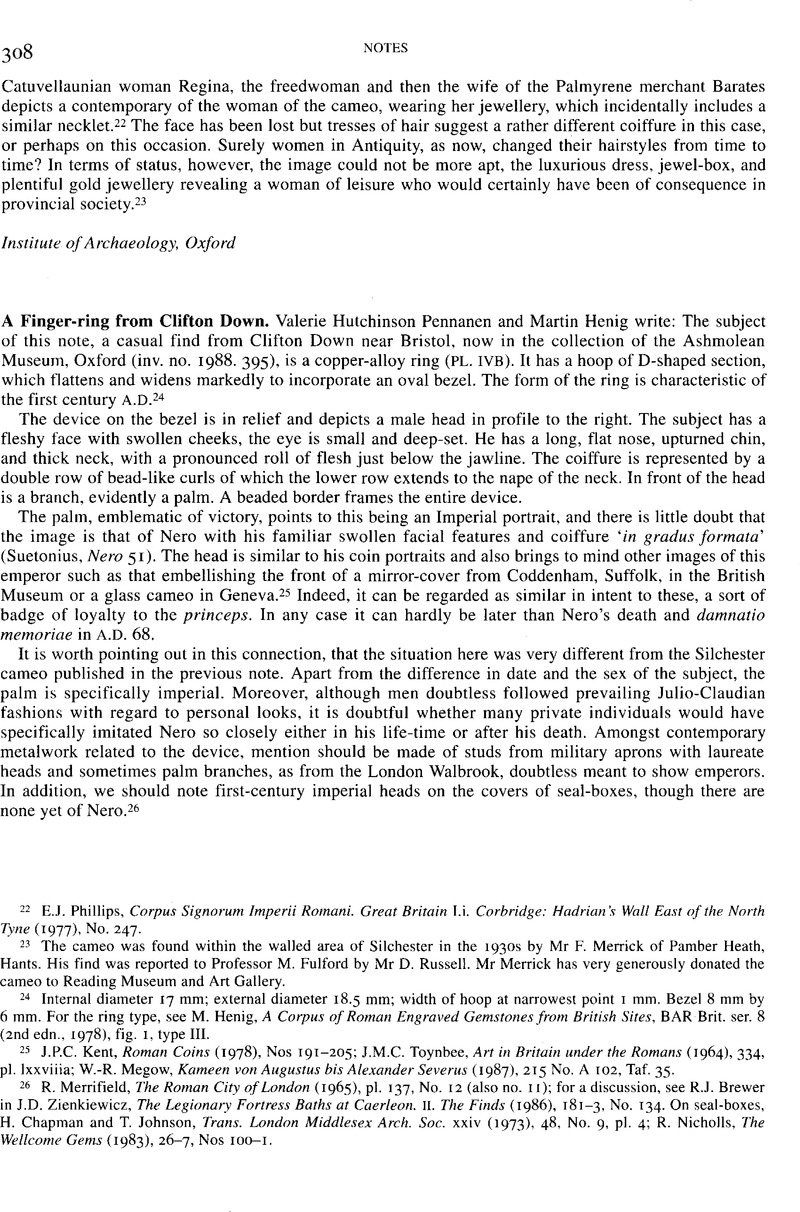No CrossRef data available.
Article contents
A Finger-ring from Clifton Down
Published online by Cambridge University Press: 09 November 2011
Abstract

- Type
- Notes
- Information
- Copyright
- Copyright © Valerie Hutchinson Pennanen and Martin Henig 1995. Exclusive Licence to Publish: The Society for the Promotion of Roman Studies
References
24 Internal diameter 17 mm; external diameter 18.5 mm; width of hoop at narrowest point 1 mm. Bezel 8 mm by 6 mm. For the ring type, see M. Henig, A Corpus of Roman Engraved Gemstones from British Sites, BAR Brit. ser. 8 (2nd edn., 1978), fig. 1, type III.
25 J.P.C. Kent, Roman Coins (1978), Nos 191–205; J.M.C. Toynbee, Art in Britain under the Romans (1964), 334, pl. lxxviiia; W.-R. Megow, Kameen von Augustus bis Alexander Severus (1987), 215 No. A 102, Taf. 35.
26 R. Merrifield, The Roman City of London (1965), pl. 137, No. 12 (also no. 11); for a discussion, see R.J. Brewer in J.D. Zienkiewicz, The Legionary Fortress Baths at Caerleon. II. The Finds (1986), 181–3, No. 134. On seal-boxes, Chapman, H. and Johnson, T., Trans. London Middlesex Arch. Soc. xxiv (1973), 48, No. 9, pl. 4; R. Nicholls, The Wellcome Gems (1983), 26–7, Nos 100–1.Google Scholar
27 Newstead, R., ‘Report on the excavations on the site of the Roman fortress at the Deanery Field, Chester (No. 2)’, Liverpool Annals Arch. and Anth. xv (1928), 17 and pl. vi, 4. A subject such as Nero and Agrippina II, Kent, op. cit. (note 25), No. 188 would be possible but there are other possibilities, even private ‘portraiture’ if this is a betrothal ring.Google Scholar
28 F. Henkel, Römischen Fingerringe der Rheinlande und der benachbarten Gebiete (1913), 83, Nos 883 and 884, with Taf. xxxiii.
29 F.H. Marshall, Catalogue of the Finger-Rings, Greek, Etruscan and Roman in the Departments of Antiquities, British Museum (1907), 45–8, Nos 259–67, 269–70, pls vi and vii. See B. Pfeiler, Römischer Goldschmuck des ersten und zweiten Jahrhunderts n.Chr. nach datierten Funden (1970), 64–6, Taf. 12.
30 Toynbee, op. cit. (note 25), 49, pl. v.
31 O. Neverov, ‘Nero-Helios’, in M. Henig and A. King, Pagan Gods and Shrines of the Roman Empire (1986), 189–94.
32 We would like to thank Mr Arthur MacGregor of the Ashmolean Museum very much for his kindness in making the ring available to us and Mr Robert Wilkins, Institute of Archaeology, Oxford for the photograph (Neg. Q 523).


